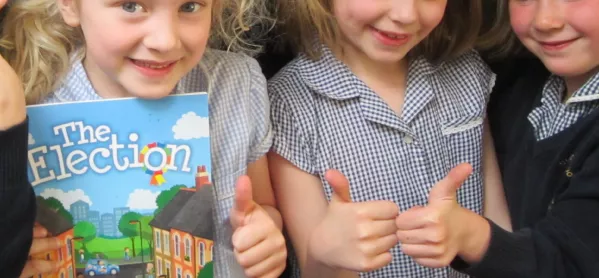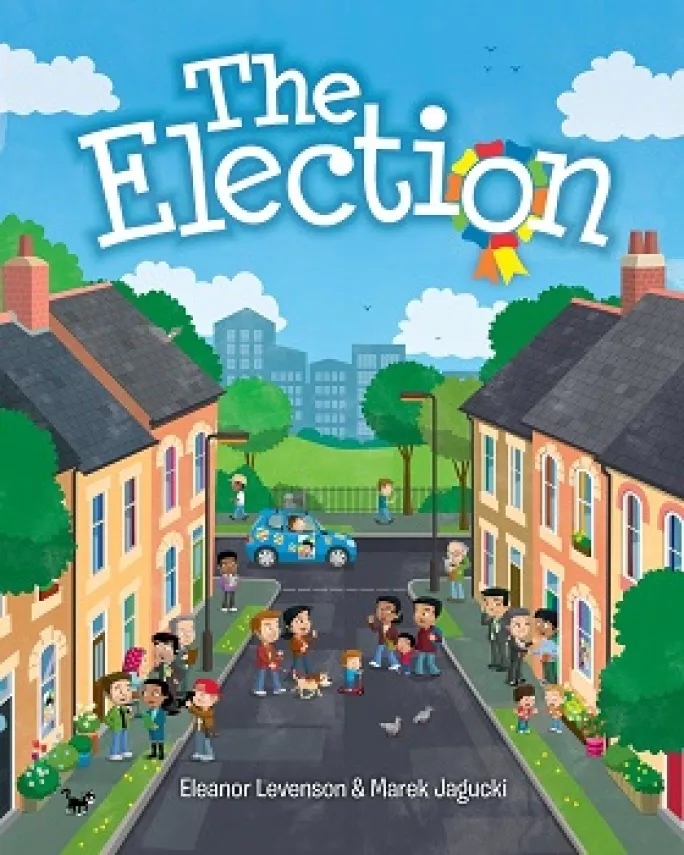- Home
- ‘The Election won with a big majority’: the class book review
‘The Election won with a big majority’: the class book review

Title: The Election
Author: Eleanor Levenson
Illustrator: Marek Jagucki
Publisher: Fisherton Press
Teacher review
The Election is a cheerful and bright picture book about democracy, voting and elections. The story follows a pre-schooler called Alex, whose parents support the Stripy Party. In the run-up to the election, Alex puts up posters, delivers leaflets and goes canvassing.
Meanwhile, his friend Evie is also helping her parents, but they support the Spotty Party. Will their friendship survive the ideological clash? And who will win the election?
This is the first UK picture book about an election, and was published in 2015 with the support of the main three UK political parties. It explains in very simple terms what an election is, what a political party is, what happens on polling day and the methods used to try and win people’s votes. The simple story also emphasises that your friends’ families may support another party, but that it is important that you can still be friends.
I must admit that my heart sank a bit when I first received the book to review. Would the simple storyline hold the interest of the children? Would they have any interest at all in elections? Would they like the illustrations, which I found clear but slightly unexciting?

After some discussion in the staff room, I decided to read the book to Dragonflies, a class of Year 2 children. We felt that the idea of an election might still be a bit abstract for Reception and Year 1, and the look and feel of the book was perhaps a bit too simple for our Juniors.
A cross on paper
I was pleasantly surprised by the reaction of Dragonflies class. They were quite engaged and had a lot to contribute. I started the session by asking if any of them knew what an election was, and none of them did. They also did not know about parties or debates and most of them were unaware who Theresa May was (they did all seem to know about Donald Trump though).
As we went through the book, they were quick to grasp the idea of the two different parties, and could pick out the different Spotty and Stripy posters and leaflets. This led to a discussion about which coloured posters they had seen in people’s windows, and all the different leaflets they were getting through their doors. When Alex went to a polling station to vote, some of the children explained how they had been to one recently in the mayoral elections, and how you needed to put a cross on the paper next to a name of a person you liked.
When Alex’s party doesn’t win (sorry: spoiler) we discussed how there will be another election in five years’ time and the Stripy party might win then. This led on to a brief discussion about democracy and how not all countries have access to it.
Cross-party allegiance
At the end of our discussion, I was surprised at how much the children had absorbed from the book, and how quickly they had picked up the ideas it seeks to explain. They understood what an election was and how people might believe different things. They knew that adults got to vote and that the party with the most votes would make important decisions (we talked about the Stripy Party making children eat a banana every day and the Spotty Party saying they had to eat an apple). They knew the party their parents supported may not win, but that they would get a chance to vote again in the future.
Most importantly, they knew that they could still play with their friends, no matter what parties their parents supported.
The Election is very simply done, but very effective at the same time. I think it is a great starting point for a discussion about elections and democracy. On the publisher’s website you can download some suggested lesson plans and activities based on the book, which is very helpful. I asked the children to vote on whether I should recommend the book, and it won with a big majority.
A great book to explain the coming election or to use as part of work on the key stage 1 British values part of the curriculum.
Sarah Ormes is school librarian at St John’s Catholic Primary School, in Bath
Pupil reviews
Emily said: “It is important to still be friends even if you like different parties.”
Chloe said: “It’s not the end of the world if you don’t win, as you get to vote again in five years.”
Rosa said: “It told you real things - it wasn’t just a story.”
And the teacher’s favourite comment: “I would vote that we get to go to the library every day.”
If you or your class would like to write a review for Tes, please contact Adi Bloom, on adi.bloom@tesglobal.com
Want to keep up with the latest education news and opinion? Follow Tes on Twitter and like Tes on Facebook
Keep reading for just £1 per month
You've reached your limit of free articles this month. Subscribe for £1 per month for three months and get:
- Unlimited access to all Tes magazine content
- Exclusive subscriber-only stories
- Award-winning email newsletters



